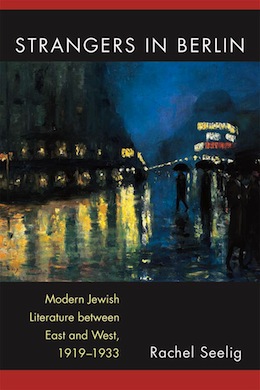Rachel Seelig, author of Strangers in Berlin: Modern Jewish Literature Between East and West, 1919-1933. (photo by Lauren Kurc)
Rachel Seelig’s Strangers in Berlin: Modern Jewish Literature Between East and West, 1919-1933 (University of Michigan Press, 2016) encompasses so many ideas – some very nuanced, others technical – that a reader will enjoy it on their own, but will learn much more if they can discuss and analyze it with others.
Strangers in Berlin uses the example of four poets – Ludwig Strauss, Moyshe Kulbak, Uri Zvi Greenberg and Gertrud Kolmar – to examine the influence that Berlin during the Weimar Republic had on Jewish literature.
“The relationship between German Jews and East European Jews in Germany typically has been depicted in terms of … German Jews figuring as reluctant hosts, cultural insiders who viewed the so-called Ostjuden as outsiders or even infiltrators,” writes Seelig. “Strangers in Berlin is aimed at destabilizing these designations by presenting Berlin as a border traversable in both directions…. Foreigners arriving from abroad availed themselves of artistic inspiration and anonymity in order to cultivate new forms of culture, while those native to Germany ascertained their increasing estrangement from the fatherland, which they similarly channeled into artistic production. Whether they were coming or going, exiled in Germany or soon-to-be-exiled from Germany, these writers experienced Berlin as a transitional site between a moribund pre-World War I political order and an increasingly divided, nationalistic European reality.”
Seelig told the Independent that she “chose to focus on four poets who are not necessarily remembered as key figures in Weimar culture but who had considerable influence in their own day.”
She explained, “One of the reasons that these poets are relatively neglected is that they are not easily categorized according to national literary boundaries. Two of them, Strauss and Greenberg, immigrated from Europe to Palestine and wrote in more than one language (Strauss in German and Hebrew and Greenberg in Yiddish and Hebrew) and the other two, Kulbak and Kolmar, produced highly diverse, avant-garde bodies of work that do not align with what we tend to see as the dominant literary trends of their day. So, these writers weren’t just ‘strangers in Berlin’ – that is, writers who are located on the margins of the cultural milieu in which they had either permanently or provisionally settled – but also strangers to us as readers in the 21st century.
“I suppose I made it my mission to bring their extraordinary writing to light, and the best way to do so was to group them together within this context of intense transition and transformation,” she said. “For all four, the experience of living in Weimar Berlin – even if only briefly – left a profound imprint on their work and on their national identity. For all four, Berlin was a place in which they were forced to renegotiate identity. Taken together, I think their works provide a fascinating glimpse into the multiplicity of images of Jewish homeland that emerged during this very fruitful yet volatile period in history.”
Weimar Berlin brought together German, Hebrew and Yiddish literature and Strangers in Berlin examines “the impact of migration – of individuals, languages and cultural concepts – on Jewish national consciousness between the world wars,” writes Seelig. She chose to focus on poets, in part, “because establishing an autonomous and multifaceted poetic tradition was a crucial component of modern national movements.”
Whereas both the Westjuden and Ostjuden “initially viewed Germany as the wellspring of liberal, Western values, by World War I, they had begun to ‘re-orient’ their gaze toward the ‘East,’ extending temporally and geographically from the ancient Near East to contemporary Eastern Europe,” writes Seelig. “Plagued by the uncertainty of national homelessness and the terror of rising antisemitism, both groups looked eastward with a combination of nostalgia, hope and despair in a effort to come to terms with the failure of the West to fulfil the promise of coexistence predicated on the liberal principles of Enlightment. Indeed, melancholic longing for the ‘East’ betrayed profound dislocation in the ‘West,’ which in turn fueled the search for a new national homeland, whether real or imagined.”
Vancouver-born and -raised, Seelig received her undergraduate degree in comparative literature at Stanford University, then worked for a time in New York. She earned her master’s and PhD in Jewish studies at the University of Chicago, spending her last couple years of graduate school in Tel Aviv. She received the Ray D. Wolfe Postdoctoral Fellowship in Jewish Studies at the University of Toronto and then, after that, returned to Israel, where she was a Mandel Postdoctoral Fellow at the Hebrew University of Jerusalem. Currently, she is a fellow at the University of Michigan’s Frankel Institute for Advanced Judaic Studies. She speaks English, Hebrew, German and Yiddish. From even this brief bio, it is no wonder that Seelig is interested in borders and thresholds.
“We live in a world today that is both utterly divided and, in a sense, borderless,” she told the Independent. “The phenomena of globalization and mass migration have made us keenly aware of the ways in which borders are, on the one hand, more easily traversed, and, on the other hand, rigourously enforced and policed. Borders have always been sites of contestation and conflict, but a border can also be seen as a threshold that one crosses from one reality to another and a productive site of transfer and transformation.
“I myself migrated across several borders as this book came into being. It started to develop as a doctoral dissertation in Chicago, which I finished writing in Tel Aviv. It became a book – one that changed shape continuously – in Toronto, Berlin and Jerusalem, and was ultimately published in Ann Arbor, Mich. My own nomadic experience as an academic (and I realize, of course, that mine is a kind of privileged nomadism) made me particularly attentive to the impact of changing surroundings and of transitions on one’s thinking, work and identity.”
While accessible, Strangers in Berlin’s dissertation origins are evident, and there are some sentences people will have to read more than once for understanding.
“Strangers in Berlin is first and foremost an academic book, which grew out of my doctoral dissertation, acknowledged Seelig. “But, in the process of transforming the dissertation into a book – and I should point out that the book departs fairly dramatically in terms of content and argument from the dissertation – I made a concerted effort to make the text engaging and highly readable by simplifying the language and peppering every chapter with interesting anecdotes. It will be used by researchers and teachers within the academic context, but I also very much hope that it will be read by lay readers who are interested in modern Jewish culture and the history of the Weimar Republic, which is such a vibrant and captivating time period. I also think that the themes of homeland and migration, which are at the centre of the book, are extraordinarily relevant today, and I hope that readers will find this glimpse into Weimar culture and history resonates with our own political reality today.”
 Certain parts of Strangers in Berlin will make readers shiver with a sense of déjà vu. In the chapter on Kolmar, for instance, Seelig writes that, in the poet’s one novel, Die jüdische Mutter (The Jewish Mother), “Kolmar offers a pained reflection on the impossibility of salvaging a viable German-Jewish female identity in an era when both Jewishness and femininity were under siege.” Seelig notes, “Conservatives seeking to safeguard their middle-class privileges and to rebuild a healthy Germany Volkskörper (national body) regarded independent women and integrated Jews as similarly ‘decadent’ social elements…. The result of this campaign was a new form of male repression, which was often shrouded in xenophobic sentiments.”
Certain parts of Strangers in Berlin will make readers shiver with a sense of déjà vu. In the chapter on Kolmar, for instance, Seelig writes that, in the poet’s one novel, Die jüdische Mutter (The Jewish Mother), “Kolmar offers a pained reflection on the impossibility of salvaging a viable German-Jewish female identity in an era when both Jewishness and femininity were under siege.” Seelig notes, “Conservatives seeking to safeguard their middle-class privileges and to rebuild a healthy Germany Volkskörper (national body) regarded independent women and integrated Jews as similarly ‘decadent’ social elements…. The result of this campaign was a new form of male repression, which was often shrouded in xenophobic sentiments.”
Readers will see similarities between the Weimar period and what is currently happening in some European countries and in the United States. As it happens, Strangers in Berlin’s launch took place the day after the U.S. presidential election.
“A few hours before the event,” she said, “I was reading an article by Chemi Shalev in the Israeli newspaper Haaretz, in which he commented that many millions of Muslims, Mexicans and Jews now feel like ‘strangers in the country they call home.’ Obviously, his statement resonated very strongly with me and with my book.
“The book deals with a historical moment, nearly a century ago, when Berlin emerged as a major metropolis that attracted large swaths of immigrants, who were often seen as unwelcome infiltrators. In this respect, 1920s Berlin isn’t such a far cry from Berlin or Toronto or New York City of today. The book really does resonate with what’s going on in the U.S. and in so much of the world.… We are witnessing the rise of nativist sentiments and attendant xenophobia and bigotry that are oh so reminiscent of interwar Europe. And we’re seeing the way in which various forms of bigotry (anti-immigration, antisemitism and misogyny, all addressed in the book) have a tendency to intersect and even merge when these nativist sentiments are bolstered by political power. I realize it’s a cliché, but it really is remarkable to see how history repeats itself. It’s such a shame that the humanities, specifically history and literature, are under attack today (Trump just eliminated funding for the National Endowment for the Humanities from his proposed budget) at a time when we so desperately need them.”
Strangers in Berlin’s four poets struggle, as we all do, with the impossibility of being one thing – a German (or any other nationality), a Jew (or any other religion), for example. Not to mention the different conceptions of what comprises a “real” German (Canadian, American, etc.) or an “authentic” Jew (within the ranges of observance, belief). From all the research Seelig has done – her work, travel, ability to speak multiple languages and negotiate various cultures – has she any theories as to why humans have such trouble, in general, with multiplicity, ambiguity, a lack of borders?
“I wish I knew why we as humans have such a hard time with ambiguity,” she said. “This is something that affects our lives not only in terms of cultural, national or political identity but also in terms of relationships, career paths, place of residence, etc. On the one hand, we have more freedom than ever before to dwell ‘between’ identities, or to inhabit more than one identity, and yet that’s somehow deeply unsettling to us as creatures that crave order, certainty and security.
“I think there’s so much to be learned by the figures in my book, who didn’t have the luxury to choose where they would live or which system of beliefs to subscribe to (at least not without the risk of persecution), and who were profoundly shaped by the contingencies and vicissitudes of life. Each of the four main writers in the book represents more than one identity and, for each one, this was certainly a source of anxiety but also a source of profound inspiration and enrichment.”

